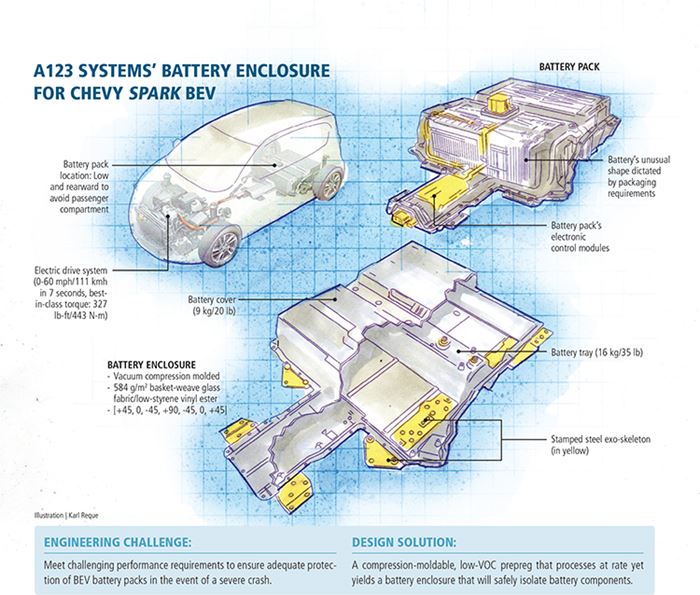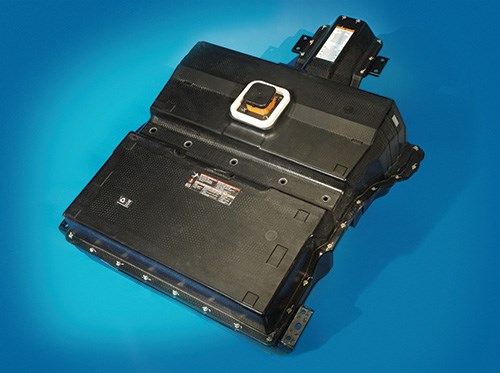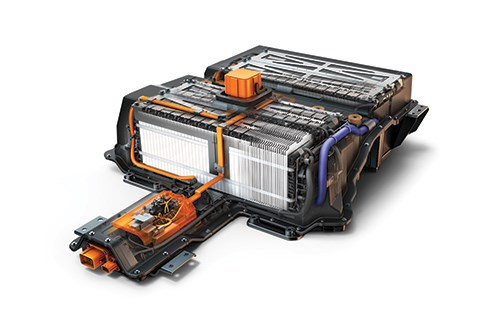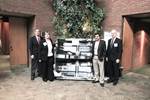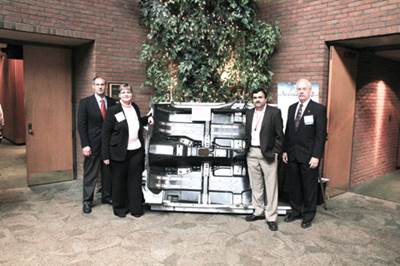Onboard protection: Tough battery enclosure
Unique composite laminate provides crash protection for electric vehicle’s battery, occupants and first responders.
Engineering Challenge:
Meet challenging performance requirements to ensure adequate protection of BEV battery packs in the event of a severe crash.
Design Solution:
A compression-moldable, low-VOC prepreg that processes at rate yet yields a battery enclosure that will safely isolate battery components.
In battery electric vehicles (BEVs), vehicle occupants, first responders and the batteries themselves must be protected from damage during catastrophic events, such as a severe crash or vehicle submersion. This is especially important because the sheer size and weight of battery packs necessitates that they be positioned low on the vehicle and rearward where there is less vehicle structure to provide such protection. To that end, General Motors Co. (GM, Detroit, Mich.) engineers designed a highly durable composite battery enclosure for the 2014 Chevrolet Spark BEV.
The “packaging” problem
A commuter car with an 82-mile/132-km range, the Spark BEV has a smaller footprint than GM’s extended-range Volt sedan EV and, therefore, less space in which to package batteries. “Package space” is critical in BEV design because the top issue consumers cite, when reluctant to buy a BEV, is the perception of insufficient driving range between charges. Driving range is, among other factors, related to battery pack size, so automakers must package the largest possible battery packs. To avoid reducing the car’s passenger capacity, rear-mounted batteries intrude on the space where the gas tank, catalytic converter, muffler, and drive system are located on combustion-engine vehicles. For the Spark, the available space dictated a complex battery configuration and demanded, in turn, an equally complex but highly damage-resistant, two-piece battery enclosure (see drawing on p. 71): A 150-cm by 110-cm by 23.5-cm (59-inch by 39-inch by 9.3-inch) lower tray and a 150-cm by 110-cm by 34.4-cm (59-inch by 39-inch by 13.50-inch) cover. The development team also went into the program with a long list of globally applicable performance requirements that the enclosure would have to meet.
Shifting gears
Until the midpoint of the Spark’s two-year development cycle, the team responsible for packaging the batteries — from GM and systems integrator A123 Systems LLC (Waltham, Mass.) — tried metals. “When we first came together, the initial design concept was to use lightweight magnesium,” explains GM’s senior materials engineer, Kestutis “Stu” Sonta. “The parts themselves were very cost-effective,” he recalls, “but we ran into issues with corrosion mitigation.” Numerous corrosion-protection options were evaluated. “The problem was,” says Sonta, “we couldn’t find a system that worked and was affordable.” Attempts to adapt other lightweight, nonferrous metals similarly failed.
“This program had an aggressive timeline and,” Sonta admits, “unfortunately [we] exhausted the first year looking at metallic solutions.” With only one year left, the team sought a composite solution. Compounder and molder Continental Structural Plastics (CSP, Auburn Hills, Mich.) and moldmaker Century Tool & Gage (Fenton, Mich.) joined the team. During the following six months, the expanded team made three major material shifts before finding a new composite material and a modified molding process that passed muster.
Early on, the new team ruled out carbon fiber composites, due to cost and galvanic-corrosion concerns, and conventional sheet molding compound (SMC), which wasn’t strong enough to meet performance criteria. To make up for time lost to metals research, the team began where the United States Center for Automotive Research (USCAR)’s Automotive Composites Consortium (ACC)’s Focal Project 4-Structural Composites Underbody program had left off. That project — in which GM, CSP, and Century Tool had participated — sought to develop a one-piece structural composite underbody/floorpan for a passenger car (see “Automotive compsoites: Strutural underbody,” under "Editor's Picks," at top right). They began with the USCAR SMC formulation and process: a CSP-compounded vinyl ester/unsaturated polyester copolymer, reinforced with a coarse basket-weave fabric (FGI 1854, nominal 5 strands/25 mm warp and 3.5 weft, with an areal weight of 584 g/m2) supplied by Fiber Glass Industries (Amsterdam, N.Y.) and processed via conventional compression molding.
“We knew after our first molding trial that this material would never work in a production environment,” recalls Sonta. “We didn’t have enough working time and after only a couple of minutes, the material began losing tack.” Constant tack is important to ensure each ply sticks to plies above and below as layers are built up so the stack doesn’t shift during transport from the layup to the tool. The team suspected the copolymer’s high styrene-monomer content might be to blame.
Compression moldable prepreg?
At that point, the team decided to change from a molding-dough (SMC)-type material to a true fabric-laminate prepreg, to gain higher mechanical performance and greater design flexibility at lower weight. However, unlike conventional thermoset prepreg, which is generally processed via vacuum bag/autoclave cure, the plan for the Spark was to process the material on a vacuum-assist compression press, just like standard SMC. Although initial volumes were expected to be low, GM wanted a process that could be scaled quickly if warranted by customer demand for the car. That meant the prepreg had to be tailored to the compression molding process.
Here, Cytec Industries Inc. (Woodland Park, N.J.) was added to the team and asked to come up with a new formulation. Cytec’s first effort was a vinyl ester prepreg with the same fabric reinforcement used by USCAR. Initially, the cloth was impregnated by pulling it through a coating bath and then calendering it between rollers to dry (flash-off) solvents used to thin the vinyl ester sufficiently for good impregnation. Although this prepreg worked better than the earlier fabric-reinforced SMC did, the team’s second molding trial showed that there was more work to do. “The solution-coating process used to produce the new prepreg didn’t remove enough solvent to eliminate volatiles that could become trapped in the center of the laminate stack and lead to voids,” remembers Chris Johnston, director, technology and processes, at CSP. “It also contributed to a high degree of variability in tack, complicating the preforming process.” Exposed to air, the material showed excessive styrene loss that could lead to molding defects and limited shelf life.
Much discussion led to a third iteration aimed at reducing the volatile-organic compounds (VOCs). They used a special vinyl ester with very-low styrene monomer content, recently commercialized by Reichhold Inc. (Durham, N.C.) for a different application, and a hot-melt coating process developed by Cytec for use without carrier solvents, but capable of achieving thorough fabric impregnation.
A third molding trial showed this combination was the key. Johnston notes that the new material offered sufficient out-time for CSP to preform, store and then mold the material several days later. It also meets tough new styrene exposure limits pending in the U.S. “Additionally,” says Sonta, “the new product was able to maintain any level of tack we wanted at any temperature, and its great shelf life gave us an extended ability to mold.” After three major material changes in six months, the team finally had something that worked.
In the final enclosure configuration, a quasi-quasi-isotropic (that is, a seven- rather than eight-layer) layup pattern [+45, 0, -45, +90, -45, 0, +45] is used to mold a tray and cover that weigh, respectively, 16 kg/35 lb and 9 kg/20 lb.
Ramping to scale
Prototypes were run on aluminum tools at Century Tool’s Fenton, Mich., facility, but production parts are now produced on steel tooling at CSP’s North Baltimore, Ohio, plant. Cytec’s prepreg rollstock is cut and labeled at CSP on a Gerber Technology (Tolland, Conn.) automated cutting table, then kitted and assembled by hand into preforms and stored until sufficient stock is built up to do a production run. A number of threaded brass inserts are insert-molded during the compression molding process. The insertion process, patented by CSP, uses inserts designed to pierce the prepreg at the onset of the molding cycle. As tonnage builds, hydraulically activated locator pins are extended to meet pin-receiving details on the threaded inserts, sealing them and preventing resin leakage into the threads. The pins retract into the tool prior to demolding.
In the finished car, a lightweight steel exo-skeleton holds the enclosure’s tray and cover together in a crash, helps attach the battery system to the underside of the vehicle, deforms under load (taking stress off of the stiffer composite during a catastrophic event) and acts as an electrically insulating “blanket” around the battery system. That assembly is “riv-bonded”— high-strength rivets and a combination of urethane adhesive and sealant connect the battery pack to a steel retention plate, which connects the battery pack to the vehicle’s underside. The rivets-and-adhesive design ensures the battery case won’t open, even in a severe crash with substantial shear forces. So far, the system is reportedly working well and is 40 percent lighter than an all-metal design would have been.
Priced as low as $19,995 USD after federal tax incentives, the Spark EV is one of the least costly BEVs on the road. Now on sale in the U.S. only in the BEV-proactive states of Oregon and California, sales locations in other states will follow as demand dictates.
Related Content
Dieffenbacher acquires Schmidt & Heinzmann composites business
The acquisition, which includes all intangible assets of the business unit, will expand Dieffenbacher’s SMC delivery spectrum, enable potential for portfolio growth and synergies.
Read MoreAOC introduces UV-Resistant Automotive System for SMC parts
AOC’s novel formulation, tested in the lab and in real-world environments, delivers a deep black, molded-in color that resists fading and offers high scratch resistance.
Read MoreComposite materials, design enable challenging Corvette exterior components
General Motors and partners Premix-Hadlock and Albar cite creative engineering and a move toward pigmented sheet molding compound (SMC) to produce cosmetic components that met strict thermal requirements.
Read MoreMatrix Composite highlights carbon fiber SMC prepreg Quantum-ESC
Prepreg produced by LyondellBasell features high flow, rapid tool loading capabilities.
Read MoreRead Next
Automotive composites: Structural underbody
For Detroit’s Big Three, a joint precompetitive composite design, development, fabrication and testing program nears successful completion.
Read MoreAll-recycled, needle-punched nonwoven CFRP slashes carbon footprint of Formula 2 seat
Dallara and Tenowo collaborate to produce a race-ready Formula 2 seat using recycled carbon fiber, reducing CO2 emissions by 97.5% compared to virgin materials.
Read MoreDeveloping bonded composite repair for ships, offshore units
Bureau Veritas and industry partners issue guidelines and pave the way for certification via StrengthBond Offshore project.
Read More
.jpg;width=70;height=70;mode=crop)
